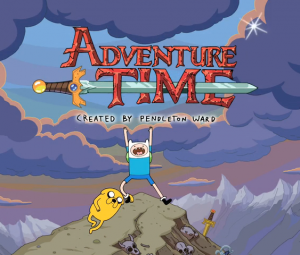The Humanism of Adventure Time: A Cartoon For Kids (and Adults) That Teaches Science and Empathy

A popular animated show on the Cartoon Network, Adventure Time, is getting praise for its humanistic themes. Matthew Bulger explains why the show is great for humanist kids (and grown-ups).
Confession: I’m 23 years old and I regularly watch a show made for children. Thankfully, I’m not alone, as many of the viewers of the kid’s show Adventure Time are seemingly well-adjusted adults.
For those of you who don’t know, Adventure Time is an animated television show in which a young boy by the name of Finn goes on adventures with his magical shape-shifting dog Jake through a post-apocalyptic world called Ooo. The show itself is based to a degree on the game Dungeons and Dragons, as most episodes involve Finn and Jake slogging through dungeons or other dangerous places to get treasure or to complete a quest for someone in need.
What draws so many people to the show is its witty sense of humor and Finn’s unwavering ethics, which provide a consistent humanist example of how a person should act. Finn is always trying to save or help somebody, not because a deity or a religion compels him to, but because Finn believes that those who are able to help others are obligated to do so as often as possible. Finn’s sense of empathy and righteousness also prevent him from acting unjustly towards villains or any of the other characters in the land of Ooo, making him a model role model for the countless children and adults that watch the show.
Aside from Adventure Time’s numerous lessons about how to be a good person, the show also consistently works to show how important science can be all while keeping the characters in a world that is seemingly full of unexplainable magic. One of the show’s main protagonists is Princess Bubblegum, who serves as ruler of the Candy Kingdom and the pre-eminent scientist in the land of Ooo. Bubblegum is constantly trying to explain to her subjects the physical nature of reality removed from the magical mumbo-jumbo that most residents of Ooo believe in, although she very rarely is successful in that effort.
A recent episode of Adventure Time called “Wizards Only, Fools” dealt with the issue of being a scientist in a world that believes in magic and superstition, as Princess Bubblegum is asked to help one of her sick subjects regain his health. Bubblegum, being a scientist, promptly comes up with a cure to the cold through medical research, only to be told by the sick subject (a candy person named Starchy that serves as the resident gravedigger) that he only accepts magical cures. Bubblegum objects and tries to forcibly inject Starchy with the cure, however the nurse that is supposed to help her refuses to do so and tells Bubblegum, “Look, I’m a nurse and all, but my uncle is a magic worker and he cured my sadness about my marriage.” Bubblegum, refusing to accept this hilarious anecdotal experience about the utility of magic, quickly retorts, “All magic is scientific principles presented like mystical hoo-doo, which is fun but it’s sort of irresponsible.”
Still, being a benevolent and doting ruler, Bubblegum sets out on a quest with Finn and Jake to retrieve a magical potion to heal Starchy. Unfortunately, magic potions are only sold to wizards, so the group must disguise themselves as magic users in order to purchase the needed potion. When they finally get to the store that will sell them the potion, Bubblegum blows their cover by demanding that the merchant tell the group how the potion is made. When the merchant aggressively replies that it is made with magic, Bubblegum skeptically replies “What’s the magic made out of, ding-dong?”
While Bubblegum’s skepticism eventually causes the group to be pursued by a magical police squad for posing as magic users, her determination to know the nature of reality free from magical descriptions shows children, especially young girls, that science is interesting and important. As Bubblegum is a positive main character, she sets an example for how children should live their lives in a way similar to Finn. While Finn works to help others through sheer will and a good heart, Bubblegum works to help those who rely on her through her study of science and her skepticism. In doing so, she makes scientific study cool and positive to kids who are just now deciding what they want to do when they grow up.
Bubblegum eventually realizes that she won’t be able to heal Starchy through magic, as she is unable to buy magic potions without letting her desire for knowledge expose her non-magical nature, so she eventually injects the original scientific cure while making “magical” hand movements and saying, “Razzle dazzle! Flooby-doo! Zamabamafoo!”
By giving Starchy a scientific cure while indulging him in his delusions about magic, Bubblegum recognizes that some people will always believe in things that are unproveable, and that their delusions should be tolerated so long as they do not negatively impact the rights or health of themselves or others. In doing so, Bubblegum shows us that our desire to know the nature of reality should not outweigh our sensitivity to the beliefs of others, no matter how ridiculous or incorrect they are. Bubblegum therefore teaches us two important lessons: how to better understand the world we live in, and how to interact with those who are set in their ways and prone to belief in superstition and magic.
While these topics may seem a bit heady for a children’s show, the humor and way the issues are presented make them approachable for people of all ages and backgrounds. Hopefully, Adventure Time will be around for years to come, as the lessons it teaches to society about skepticism, ethics, and empathy are truly valuable.
